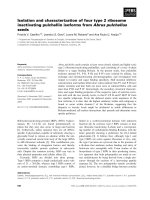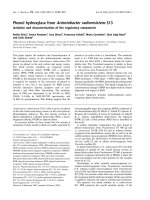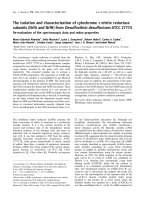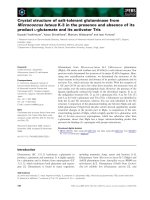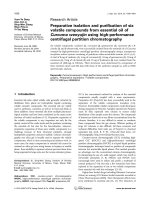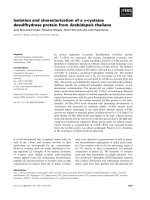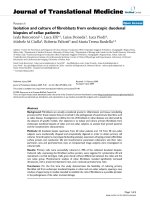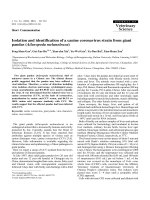isolation and selection of thermo tolerant yeasts from alcoholic fermentation starter
Bạn đang xem bản rút gọn của tài liệu. Xem và tải ngay bản đầy đủ của tài liệu tại đây (1.07 MB, 31 trang )
MINISTRY OF EDUCATION & TRAINING
CAN THO UNIVERSITY
BIOTECHNOLOGY RESEARCH & DEVELOPMENT INSTITUTE
SUMMARY
BACHELOR OF SCIENCE THESIS
THE ADVANCED PROGRAM IN BIOTECHNOLOGY
ISOLATION AND SELECTION OF
THERMO-TOLERANT YEASTS FROM
ALCOHOLIC FERMENTATION STARTER
SUPERVISOR
STUDENT
Assoc.Prof. NGO THI PHUONG DUNG
HUYNH QUOC KHANH
Studentcode: 3102818
Session: 36 (2010-2014)
Can Tho, 2014
MINISTRY OF EDUCATION & TRAINING
CAN THO UNIVERSITY
BIOTECHNOLOGY RESEARCH & DEVELOPMENT INSTITUTE
SUMMARY
BACHELOR OF SCIENCE THESIS
THE ADVANCED PROGRAM IN BIOTECHNOLOGY
ISOLATION AND SELECTION OF
THERMO-TOLERANT YEASTS FROM
ALCOHOLIC FERMENTATION STARTER
SUPERVISOR
STUDENT
Assoc.Prof. NGO THI PHUONG DUNG
HUYNH QUOC KHANH
Studentcode: 3102818
Session: 36 (2010-2014)
Can Tho, 2014
APPROVAL
SUPERVISOR
STUDENT
NGO THI PHUONG DUNG
HUYNH QUOC KHANH
Can Tho, December
, 2014
PRESIDENT OF EXAMINATION COMMITTEE
i
ABSTRACT
In this research, 40 yeast strains that were isolated from alcoholic fermentation
starters were examined for morphology, physiology, biochemistry, thermo-tolerant
ability at 30, 35, 37, 40, 43, and 45ºC, and for their ethanol tolerant ability at 3, 6, 9,
and 12% v/v ethanol. The yeast isolates with high thermo-tolerant and ethanol tolerant
ability were further tested for ethanol fermentation ability in 2% w/v glucose liquid
and ethanol fermentation ability in molasses at high temperatures (30, 35, 40 and
42ºC). The results showed that most of the yeast’s cells are spherel, oval and ellipse,
size range from (5-15) µm x (2-10) µm. Based on the characteristics of morphology,
physiology and biochemistry, 40 yeast isolates were classified as follows:
Saccharomyces, Kluyveromyces and Hansenspora. 27 yeast isolates were found to be
able for growth at temperature 43oC. 29 yeast isolates were able for growth in the
medium containing 12% v/v ethanol. Among them, three yeast isolates including CT,
HG2 and TO1 had the high capacity of ethanol fermentation in 2% w/v glucose
medium than others. CT, HG2 and TO1 were able to produce ethanol at temperature
of 42oC and with ethanol concentrations in the medium folowed 3.03% v/v, 2.69% v/v
and 2.77% v/v respectively. The result of molecular analysis of ITS1, 5.8S rDNA, and
ITS2 sequence showed that the TO1 yeast isolate belonged to Saccharomyces
cerevisiae with 93% homogeneous level.
Key words: ethanol fermentation, ethanol tolerant ability, Saccharomyces cerevisiae,
thermo-tolerant ability, thermo-tolerant yeast.
ii
CONTENTS
APPROVAL ....................................................................................................................i
ABSTRACT .................................................................................................................. ii
CONTENTS ................................................................................................................. iii
CHAPTER 1: INTRODUCTION ................................................................................1
1.1. Introduction ......................................................................................................1
1.2. Objectives ..........................................................................................................2
CHAPTER 2: MATERIALS AND METHODS ......................................................... 3
2.1. Materials ...........................................................................................................3
2.2. Method ..............................................................................................................3
2.2.1. Isolation .......................................................................................................3
2.2.2. Morphological, physiological and biochemical Characteristics .................3
2.2.3. Testing thermo-tolerant ability of yeast isolates .........................................4
2.2.4. Testing ethanol tolerant ability of yeast isolates .........................................4
2.2.5. Study on ethanol fermentation ability of selected yeast isolates in glucose
liquid
.....................................................................................................................4
2.2.6. Study on ethanol fermentation ability of selected yeast isolates at high
temperature ...............................................................................................................5
2.2.7. Identification of the selected thermo-tolerant yeast isolates .......................5
2.2.8. Statistical data analysis ...............................................................................5
CHAPTER 3. RESULTS AND DISCUSSION ........................................................... 6
3.1. Isolation .............................................................................................................6
3.2. Morphological, physiological and biochemical tests .....................................6
3.3. Testing thermo-tolerant ability of yeast isolates .........................................14
3.4. Testing ethanol tolerant ability of yeast isolates .........................................16
3.5. Ethanol fermentation ability of selected yeast isolates in glucose liquid ..19
iii
3.6. Ethanol fermentation ability of CT1, HG2 and TO1 yeast isolates at high
temperature ..............................................................................................................21
3.7. Identification of the TO1 yeast isolate ......................................................... 22
CHAPTER 4. CONCLUSIONS AND SUGGESTIONS ..........................................24
4.1. Conclusions .....................................................................................................24
4.2. Suggestions......................................................................................................24
REFERENCES ............................................................................................................25
iv
CHAPTER 1: INTRODUCTION
1.1.
Introduction
For a long time, ethanol has many applications in life and industry. Ethanol is
commonly known as beverages, or it can be used as an antiseptic, inhibitor or material
for synthesisother organic compound, depending on the concentration and uses...
Furthermore, ethanol was also assessed as a bio-fuel that has the potential to replace
fossil fuels (Alfenore et al., 2002).
The use of yeast to produce ethanol from sugar has a great advantage because
sugar may be obtained from agricultural residues such as straw, corn stalks, molasses...
These are cheap and diversematerials in agriculture based countries. However, there
are many factors affecting the activity of the yeast as carbon sources, nitrogen sources,
pH, concentration of ethanol, temperature...
Temperature is an important factor affecting the efficiency of ethanol
fermentation process, especially in the tropics, where the average temperature is high
throughout the year. The advantage of the high-temperature fermentation is that
fermentation will occur more quickly, reducing the risk of microbial contamination,
saving cooling costs... (Roehr, 2001).
However, in case the temperature is too high or ethanol concentrations exceed
the tolerant of yeast, fermentation will be inhibited, leading to low efficiency of
fermentation. Therefore, the selection of yeast strains that is capable of growing,
fermentating at high temperatures and withstanding high ethanol concentration is very
promising for the production of ethanol.
The climate in the Mekong Delta region is hot and humid all year-round, it is
very suitable to growth andenhance yeast and yeast populations are. The probability to
obtain yeast strains possessing the desirable characteristics for developing original
starter for industrial production and research on ethanol fermentation in high
temperature conditions is entirely feasible.
Currently, the country had few researchs on thermo-tolerant yeast in alcoholic
fermentation starter. Consequently, researchs on isolating yeast strains to apply in the
1
ethanol production are in need. That was the reasons why the topic "Isolation and
selectionthermo-tolerant yeast in alcoholic fermentation starter" is done.
1.2.
Objectives
The aim of this study is isolation and selection of thermo-tolerant and ethanol-
tolerant yeast from alcoholic fermentation starter and capable of fermentation ethanol
at high temperature in molasses.
2
CHAPTER 2: MATERIALS AND METHODS
2.1.
Materials
Molasses (collected from Phung Hiep Sugar Factory, Nga Bay Town, Hau
Giang Province).
Alcoholic fermentation starter collected from markets in the location: Chau Phu
District and Long Xuyen City, An Giang Province; Bac Lieu City, Bac Lieu Province;
Ca Mau City, Ca Mau Province; Ninh Kieu District, O Mon District and Thot Not
District, Can Tho City; Lap Vo District, Dong Thap Province; Phung Hiep District,
Hau Giang Province; Vinh Chau Town, Soc Trang Province; Tra Cu District, Tra Vinh
Province; Tra On District, Vinh Long Province.
Devices: oven, microscope, electric stove, flasks, pH meter, water-lock,
refractometer…
Media: + YPD agar (2% D-glucose, 2% agar, 0.5% yeast extract, 0.5% peptone
w/v, adding tetracyclin 50 mg/500 mL media).
+ YPD broth (2% D-glucose, 0.5% yeast extract, 0.5% peptone w/v).
Chemicals: C2H5OH, NaCl, NaHSO3, NaOH, HCl...
2.2.
Method
2.2.1. Isolation
Purpose: selecting pure yeast strains from alcoholic fermentation starter.
Method: weighing 1 g alcoholic fermentation starter and increasing biomass in
YPD mediumfor 48 hours on a shaker. Diluting media into lower concentraions, the
suspension of each concentration was transplanted into a petri dish containing YPD
agar medium, incubate at 30oC for 48 hours, observedcolonies, continued to transplant
each different single colony to a petri dish until having got pure strains.
2.2.2. Morphological, physiological and biochemical Characteristics
a. MorphologicalCharacteristics
Purpose: identifying the characteristics including shape and size of yeast
colonies and cells.
Method: yeastisolates were transplanted into a petri dish containing YPD agar
medium incubate at 30oC for 48 hours, measured the shape and size of colonies.
3
Observing the morphology of yeast under a X100 objective optical microscope
andmeasuring the size and shape and photograph yeast cells
b. Testing physiology and biochemistry characteristics
Determination ethanol fermentation ability of yeast isolates in glucose,
saccharose and maltose liquid: ethanol fermentation ability of yeast isolates in
glucose liquid was determined by measuring the CO2 height in Durham test tubes
produced by yeasts. Yeast isolates were inoculated into YPD medium for 24 hours.
Then, suspensions of yeast isolates were inoculated into Durham tubes containing 2%
w/v glucose liquid, and incubated at room temperature. Measure the accumulation of
CO2 gas in the inner Durham tubes at 4, 8, 12, 16, 20, and 24 hours. Do same as above
with saccharose and maltose liquid.
Determination urease enzyme activity: christensen urea broth media was
prepared and sterilized at 115oC for 1 hour. Then, yeast isolates were transplanted and
incubatedat 30oC for 48 hours. A positive result could be observed in case the medium
color turns into pink.
2.2.3. Testing thermo-tolerant ability of yeast isolates
Yeasts were inoculated into YPD medium for 48 hours. Thermo-tolerant ability
of yeast isolates was determined by culturing the yeasts on YM agar medium and
incubating at 30, 35, 37, 40, 43 and 45ºC in 48 hours. The isolates forming colonies at
high temperatures were recorded.
2.2.4. Testing ethanol tolerant ability of yeast isolates
Yeast isolates were inoculated into YPD medium for 48 hours. Ethanol tolerant
ability of yeast isolates was determined by culturing the yeasts on YM agar medium
supplemented with pure ethanol at levels of 3, 6, 9, and 12% v/v and incubating at
30ºC in 48 hours. The isolates forming colonies on high ethanol concentration
supplemented medium were recorded.
2.2.5. Study on ethanol fermentation ability of selected yeast isolates in glucose
liquid
Ethanol fermentation ability of yeasts was determined by measuring the CO2
height in Durham test tubes produced by yeasts. Yeast isolates were inoculated into
YPD medium for 24 hours. Then, suspension of yeast cells was inoculated into
4
Durham tubes containing 2% w/v glucose liquid of, and incubated at room
temperature. Measure the accumulation of CO2 gas in the inner Durham tubes each 2
hours in 24 hours.
2.2.6. Study on ethanol fermentation ability of selected yeast isolates at high
temperature
Yeast isolates were inoculated into YPD medium for 24 hours. The 1 mL of
pre-culture yeasts determined the density of 106 cells/mL was inoculated into 99 mL of
22oBrix molasses medium sterilized at 121ºC for 15 minutes. Incubate the molasses
medium anaerobically at 30, 35, 37, 40, and 42ºC for five days. Ethanol content after
fermentation was determined by distillation method.
2.2.7. Identification of the selected thermo-tolerant yeast isolates
Yeast strain are sent to the Microgene company for DNA extraction and
amplification regions ITS1, ITS2 and 5.8S rDNA by PCR. Nucleotide sequence was
aligned
and
compared
with
the
data
obtained
from
Gene
Bank
( and determine the species of yeast strains.
2.2.8. Statistical data analysis
The statistical data were analyzed by Microsoft Office Excel 2010 and
Statgraphics centurion XVI (USA) software.
5
CHAPTER 3. RESULTS AND DISCUSSION
3.1.
Isolation
Forty isolates were obtained from alcoholic fermentation starter sources are
denoted: AA1, TV1, AG*, AG1, AG1.1, AG2, AG3.3, BD1, BD2, BL1, BL2, BL3, BL4,
CM2, CM2.2, CM3, OM1, CM4.4, OM2, OM3, CT1, CT2, TV2, TV3, OM4, DT1, HG1,
HG2, TV4, NK2, NK4, ST2, TB1, TG1, DT2, TNN3, TNN4, TO1, TO2, ST1.
3.2.
Morphological, physiological and biochemical tests
According to Nguyen Lan Dung et al. (1998) and Nguyen Duc Luong et al.
(2004) yeast strains can be identified preliminarily base on morphological and
physiological characteristics. Morphological characteristics include: description of the
yeast cell morphology when grown on the PGA medium for 2 days, the formation of
budding cells and budding style when cultured on peptone - yeast extract – glucose
medium after a period of 2 or 3 days incubation, the sporulation of yeast cultured on
agar – water medium after a period of 14 days. Physiological characteristics include:
the ability to ferment sugars and urea assimilation ability of yeast.
a. Morphological characteristics of yeast
General morphology of yeast strains includes the following types: 40 strains
isolates were variety of shapes and sizes. Yeast colonies had a convex shape, about 1-3
mm in diameter and 0.1 mm thickness. Some colonies surfaced smooth or rough. Most
of colonieshad white color. The shapes of typical yeast colonies are shown in Figure 1.
6
1a
1b
1c
1d
Figure 1.The shape of typical colonies of yeast strains
*Note: (1a): HG2, (1b): CT2, (1c): BL4, (1d): TNN4
The result of yeast cells morphological features observed under a microscope
showed that the shape of yeast cells were very diverse, consisting mainly sphere, oval
and ellipse. The size of the yeast cells ranged 5-15 µm and a width in the range of 2-10
µm. Based on morphological characteristics of the yeast cell, 40 yeast strainsisolates
could be divided into five main groups. These group names were shown in Table 1.
7
Table 1. Shape of yeast colonies
Group
Yeast cell
Yeast strains
shapes
Quantity
AA1, BD1, CM2.2, DT1, ST2, TB1,
Group 1
Large Sphere
Group 2
Large Oval
DT2, CT1, HG2, ST1, TO1
5
Group 3
Small Oval
AG1, BD2, BL4, CM3, TO2, OM1
6
Group 4
Large Ellipse
Group 5
Small Ellipse
TG1, TNN3
AG*, AG1.1, AG3.3, OM3, CT2, HG1,
AG2, TV1, TV4
BL1, BL2,BL3, CM2, CM4.4, OM2,
OM4, TV2, TV3, NK2, NK4, TNN4
Total
8
9
12
40
Main yeast cells shapes are showed in figure 2
Goup1: Large Sphere
Group 2: Large Oval
Group 3: Small Oval
Group 4: Large Ellipse Group 5: Small Ellipse
Figure 2. Main shapes of five yeast trains group at objective lens X100
Specific detailed characteristics of each yeast strain forms are listed in in Table 2
8
Table 2. Morphological Characteristics of yeast strains isolates
Number
Yeast
strains
Colonies description
Diameter
Thickness
Convex/
(mm)
(mm)
crateriform
Cells Features
Surface,Margin
Color
Size
(µm)
1
AA1
2-2.5
0.1
Convex
Smooth, entire
White 10x10
2
AG*
2-2.5
0.1
Convex
Smooth, entire
White
10x5
3
AG1
2-2.3
0.1
Convex
Smooth, entire
White
6x5
4
AG1.1
2-2.4
0.1
Convex
Smooth, entire
White
10x5
5
AG2
1-1.5
0.1
Convex
Rough, entire
White
10x5
6
AG3.3
2-2.2
0.1
Convex
Rough, entire
White
10x5
7
BD1
1.5-2
0.1
Convex
8
BD2
2-2.3
0.1
Convex
9
BL1
1.5-2
0.1
Convex
10
BL2
1.5-2
0.1
Convex
11
BL3
2-2.5
0.1
Convex
12
BL4
1.5-2
0.1
Convex
13
CM2
1.5-2
0.1
Convex
14
CM2.2
1.5-2
0.1
Convex
15
CM3
2-2.5
0.1
Convex
16
CM4.4
1-1.5
0.1
Convex
9
Rough,
filiform
Rough,
White 10x10
White
4x3
Smooth, entire
White
5x3
Rough, entire
White
4x3
White
7x3
White
4x2
White
6x3
White
8x8
White
4x3
White
6x2
filiform
Smooth,
Filiform
Rough,
undulate
Rough,
undulate
Rough,
Filiform
Smooth,
undulate
Smooth, entire
Shape
Large
Sphere
Large
Ellipse
Small
Oval
Large
Ellipse
Large
Ellipse
Large
Ellipse
Large
Sphere
Small
Oval
Small
Ellipse
Small
Ellipse
Small
Ellipse
Small
Oval
Small
Ellipse
Large
Sphere
Small
Oval
Small
Ellipse
17
CT1
1-1.5
0.1
Convex
Rough, entire
White 12x12
18
CT2
2-2.5
0.1
Convex
Smooth, entire
White
12x5
19
DT1
2-2.6
0.1
Convex
Rough, entire
White
9x9
20
DT2
2-2.3
0.1
Convex
White
8x7
21
HG1
1.5-2
0.1
Convex
Smooth, entire
White
10x5
22
HG2
1-2
0.1
Convex
Rough, entire
White
10x8
23
NK2
2-2.5
0.1
Convex
Smooth, entire
White
8x4
24
NK4
1.5-2
0.1
Convex
Smooth, entire
White
6x4
25
OM1
2-2.5
0.1
Convex
White
3x2
26
OM2
2-2.5
0.1
Convex
Smooth, entire
White
5x3
27
OM3
1-2
0.1
Convex
Smooth, entire
White
10x5
28
OM4
2-2.5
0.1
Convex
Rough, entire
White
6x4
29
ST1
1.5-2
0.1
Convex
Smooth, entire
White
8x7
30
ST2
2-2.5
0.1
Convex
Smooth, entire
White 10x10
31
TB1
2-2.5
0.1
Convex
Smooth, entire
White 10x10
32
TG1
1- 2
0.1
Convex
Rough, entire
White 13x13
33
TNN3
1.5-2
0.1
Convex
Rough, entire
White 12x12
34
TNN4
2-2.5
0.1
Convex
Smooth, entire
White
7x4
35
TO1
1.5-2
0.1
Convex
Smooth, entire
White
8x7
10
Rough,
undulate
Smooth,
Filiform
Large
Sphere
Large
Ellipse
Large
Sphere
Large
Oval
Ellipse
lớn
Large
Oval
Small
Ellipse
Small
Ellipse
Small
Oval
Small
Ellipse
Large
Ellipse
Small
Ellipse
Large
Oval
Large
Sphere
Large
Sphere
Large
Sphere
Large
Sphere
Small
Ellipse
Small
Oval
36
TO2
2-2.5
0.1
Convex
Smooth, entire
White
6x5
37
TV1
2-2.5
0.1
Convex
Smooth, entire
White
13x6
38
TV2
1-1.5
0.1
Convex
Smooth, entire
White
8x4
39
TV3
1-2
0.1
Convex
Smooth, entire
White
7x4
40
TV4
2-2.5
0.1
Convex
Smooth, entire
White
10x6
Small
Oval
Large
Ellipse
Small
Ellipse
Small
Ellipse
Large
Ellipse
b. Testing physiology and biochemistry characteristics
Determination ethanol fermentation ability of yeast isolates in glucose,
saccharose and maltose liquid:
The results of test showed that 40 yeast strains isolates could be classified into 3
groups: group I (capable of fermenting), group II (weak fermentation) and group III
(incapable of fermentaion) shown in Table 3.
11
Table 3. Fermentation ablility of yeast strains isolates
Types of
sugar
Group I
Group II
Group III
AA1, AG*, AG1, AG1.1,
AG2, BD2, BL1, BL2, BL3,
BL4, CM2, CM2.2, CM3,
Glucose
CM4.4, CT1, DT1, DT2,
AG3.3, BD1, CT2,
HG1, HG2, NK2, NK4,
OM3, ST2, TV3, TV4.
OM1, OM2, OM4, TB1,
TG1, TNN3, TNN4, TO1,
TO2, TS2,TV1, TV2.
Saccharose
AA1, BL1, BL2, CM2.2,
AG*, AG1.1, AG2,
CM4.4, CT1, DT1, DT2,
AG3.3, BD1, BL3, BL4,
HG2, ST2, TB1, TG1,
CM2, CT2, HG1, NK2,
TNN3, TNN4,
NK4, OM2, OM3, OM4,
TO1.
TV1, TV2, TV3, TV4.
AG1, BD2, BL4,
CM3, OM1, TO2.
.
AA1, AG1, AG1.1, AG3.3,
BD1, BD2, BL1, BL2, BL3,
BL4, CM2, CM2.2, CM3,
Maltose
CM4.4, CT1, CT2, DT1,
AG*, AG2, HG1, ST2,
DT2, HG2, NK2, NK4,
TV1, TV4.
OM1, OM2, OM3, OM4,
TB1, TG1, TNN3, TNN4,
TV2, TV3, TO1, TO2, TS2
The results showed that all yeast isolateshad the ability to use maltose and
glucose. Meanwhile, there were 34 yeast strains capable to ferment saccharose.
The ability to ferment sugars is an important feature in ethanol producing
process. Therefore, the testof ethanol fermentation ability of yeast isolates in glucose,
saccharose and maltose liquidwill be one of the criteria for classification of yeast,
while it is the initial selection of the appropriate yeast strains for fermentation of
various types of substrates in order to take full advantage of sugar source in substrate,
because composition and proportion of sugar in each type of substrate is very different.
12
Determination urease enzyme activity:
a
b
c
+
d
-
e
Figure 3: Urea media vitroes before and after 48 hours incubation
*Note: (3a): Urea media before yeast transplanting
(3b), (3c), (3d): Urea media after yeast transplanting and 48 hours incubation
(3e): positive (left) and negative (right) control samples
Table 4 shows the results of determination urease enzyme activity of yeast
strains isolates.
Table 4. Urease enzyme activity of yeast strains isolates
Result
Positive (+)
Nagative (-)
Yeast strains
BL2, BL1, HG1.
AA1, AG*, AG1, AG1.1, AG2, AG3.3,
BD1, BD2, BL3, BL4, CM2, CM2.2, CM3,
CM4.4, CT1, CT2, DT1, DT2, HG2, NK2,
NK4, OM1, OM2, OM3, OM4, ST1, ST2,
TB1, TG1, TNN3, TNN4, TO1, TO2, TV1,
TV2, TV3, TV4.
quantity
3/40
37/40
*Note: "+" medium turned into pink, "-"medium remained previous color. Values in the table are the
average of three repetitions.
The results showed that, after 48 hours incubation, 3 tubes turned into pink
color: BL2, BL1, HG1 and 37 tubes all of yeast strains belong to groups 1, 2 and 3
remained yellow color, it means 37 yeast trains are incapable to analyze urea.
13
According to Booth and Vishniac (1987), the presence of urease enzyme plays
a key role in the urea hydrolysis in yeast. In Urea Broth medium with color indicator
phenol red, with a pH of 6.8 ± 0.2, medium color is orange. However, if the yeast
strains are able to create urease enzyme to hydrolyze urea, CO2 and NH3 will be
formed. The formation of NH3 will make pH increase and environment change to pink.
Preliminary Identification of yeast strains
Yeast strains can be identified preliminarily based on morphological,
physiological andbiochemical characteristics.
40 yeast strains isolates were identified preliminarily in Table 5
Table 5. The result of preliminary identification of 40 yeast strains islolates
Morphological
Physiological, biochemical
characteristics
characteristics
Preliminary
Group
Cells
shape
1
2
3
4
5
Large
Budding
Saccharose
Maltose
fermentation
multiple
Urea
identification
fermentation hydrolysis
+
+
-
Saccharomyces
multiple
directions
+/-
+/-
-
Saccharomyces
Oval
multiple
directions
-
+/-
-/+
Hanseniaspora
Large
bipolarity
+/-
+/-
-/+
Kluyveromyces
+/-
+/-
-/+
Kluyveromyces
Sphere directions
Large
Oval
Small
Ellipse
Small
multiple
Ellipse directions
*Note: "+": capability, "-": incapability
The result showed that yeast strains in Group 1 and 2 belong to
Saccharosemyces spp., yeast strains in Group 3 belong to Hanseniaspora spp., yeast
strains in Group 4 and 5 belong to Kluyveromyces spp.
3.3.
Testing thermo-tolerant ability of yeast isolates
The thermo-tolerant ability of yeasts was determined based on the growth of
colonies at high temperature after 48 hours.
14
Thermal-tolenrant ability of 40 yeast strains isolates are shown in Table 6:
Table 6. Thermal-tolenrantablitiyof 40 yeast strains isolates
Name
30oC
35oC
37oC
40oC
43oC
45oC
AA1
+
+
+
+
-
-
TV1
+
+
+
+
+
-
AG*
+
+
+
+
+
-
AG1
+
+
+
+
+
-
AG1.1
+
+
+
+
+
-
AG2
+
+
+
+
+
-
AG3.3
+
+
+
-
-
-
BD1
+
+
+
+
-
-
BD2
+
+
+
+
+
-
BL1
+
+
+
+
-
-
BL2
+
+
+
+
-
-
BL3
+
+
+
+
+
-
BL4
+
+
+
+
+
-
CM2
+
+
+
+
-
-
CM2.2
+
+
+
+
+
-
CM3
+
+
+
+
+
-
OM1
+
+
+
+
-
-
CM4.4
+
+
+
+
+
-
OM2
+
+
+
+
+
-
OM3
+
+
+
+
+
-
CT1
+
+
+
+
+
-
CT2
+
+
+
+
-
-
TV2
+
+
+
+
+
-
TV3
+
+
+
+
+
-
OM4
+
+
+
+
+
-
DT1
+
+
+
+
-
-
HG1
+
+
+
+
-
-
HG2
+
+
+
+
+
-
TV4
+
+
+
+
+
-
NK2
+
+
+
+
+
-
NK4
+
+
+
+
+
-
ST2
+
+
+
+
-
-
15
TB1
+
+
+
+
+
-
TG1
+
+
+
+
+
-
DT2
+
+
+
+
-
-
TNN3
+
+
+
+
+
-
TNN4
+
+
+
+
+
-
TO1
+
+
+
+
-
-
TO2
+
+
+
+
+
-
TS2
+
+
+
+
+
-
Total
40
40
40
39
27
0
*Note: “+”: forming colonies, “–”: no forming colonies
2
1
3
6
4
5
Figure 4. Some thermo-tolerant yeast at 43oC
*Note: (1): TO1, (2): CT1, (3): HG1, (4): TNN4, (5) : TB1, (6) :HG2
After 48 hours incubation, all 44 yeast isolates formed colonies at 30 - 37ºC, 39
and 27 yeast isolates formed colonies at 40ºC and 43ºC. At 45ºC, there were no yeast
isolates formed colonies. It showed that temperature is one of the major factors
effecting on the development of yeasts. The higher the temperature is, the
smallernumbers of yeast colony forming are. 27 yeast strains grown at high
temperature (43oC) were used in further experiments.
3.4.
Testing ethanol tolerant ability of yeast isolates
The ethanol tolerant ability of yeasts was determined based on the growth of
forming colonies at high ethanol concentration after 48 hours.
The growth of yeast strains isolated in medium with addition ethanol
concentration 3, 6, 9 and 12% are shown in Table 7.
16
Table 7. Ethanol tolerant ability of yeast isolates
Yeast strains
3%
6%
9%
12%
AA1
+
+
+
+
TV1
+
+
+
+
AG*
+
+
+
+
AG1
+
+
+
+
AG1.1
+
+
+
+
AG2
+
+
+
+
AG3.3
+
+
+
-
BD1
+
+
+
+
BD2
+
+
+
-
BL1
+
+
+
+
BL2
+
+
+
+
BL3
+
+
+
+
BL4
+
+
+
-
CM2
+
+
+
+
CM2.2
+
+
+
-
CM3
+
+
+
+
OM1
+
+
+
+
CM4.4
+
+
+
-
OM2
+
+
+
+
OM3
+
+
+
+
CT1
+
+
+
+
CT2
+
+
+
+
TV2
+
+
+
+
TV3
+
+
+
+
OM4
+
+
+
+
DT1
+
+
+
+
HG1
+
+
+
+
17
HG2
+
+
+
-
TV4
+
+
+
+
NK2
+
+
+
+
NK4
+
+
+
+
ST2
+
+
+
-
TB1
+
+
+
+
TG1
+
+
+
-
DT2
+
+
+
+
TNN3
+
+
+
+
TNN4
+
+
+
-
TO1
+
+
+
+
TO2
+
+
+
-
ST1
+
+
+
-
Sum
40
40
39
29
*Note: “+”: forming colonies, “–”: no forming colonies
2
1
6
3
5
4
Figure 5. Some ethanol tolerant yeast trainsat ethanol concentration 12%
*Note: (1): TO1, (2) : CT1, (3): HG2 (4): HG2, (5) : TNN4 (6) :
18
After 48 hours incubation, all yeast isolates formed colonies in the medium
supplemented with 3% and 6% of ethanol. In 9% ethanol contained medium, 39
isolates formed colonies. The number of yeast isolates forming colonies decreased
when the supplemented ethanol concentration increased. As the results, 29 yeast
isolates formed colonies in the medium containing 12% ethanol. This proved that
ethanol was one of the major factors affecting on the growth of yeast strains. Ethanol
inhibited the growth of yeast. By the way, higher concentrations of ethanol could
cause poison for yeast.
From the results of 4.1 and 4.2, 27 thermol-tolerant and ethanol tolerant yeast
were selected: TV1, AG*, AG1, AG1.1, AG2, BD2, BL3, BL4, CM2.2, CM3, CM4.4,
OM2, OM3, CT1, TV2, TV3, OM4, HG2, TV4, NK2, NK4, TB1, TG1, TNN3,
TNN4, TO1, ST1. Twenty-seven lines of yeast were used in further experiments.
3.5.
Ethanol fermentation ability of selected yeast isolates in glucose liquid
Ethanol fermentation ability of seven yeast isolates was determined based on
their CO2 production in Durham test tubes after 24 hours of fermentation. The results
were presented in Table 8.
19
